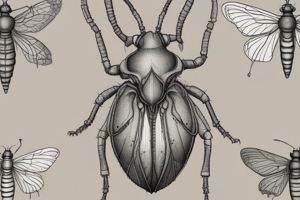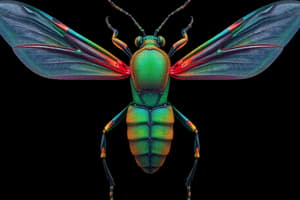Podcast
Questions and Answers
Which statement accurately describes the role of insects in ecosystems?
Which statement accurately describes the role of insects in ecosystems?
- Insects are food sources for various animals and contribute to organic decomposition. (correct)
- Insects only reside in agricultural settings and their ecological impact is minimal.
- Insects are primarily harmful and do not significantly aid in ecological balance.
- Insects only contribute to pollination and have no other ecological roles.
What is a primary focus of agricultural entomology?
What is a primary focus of agricultural entomology?
- Studying the genetic makeup of insects.
- Examining the evolutionary history of insect orders.
- Developing strategies to control pest insects affecting crops. (correct)
- Understanding insect behavior for entertainment purposes.
Which factor is essential for the effective study of entomology?
Which factor is essential for the effective study of entomology?
- Understanding the specific characteristics of various insect orders. (correct)
- Focusing solely on the Coleoptera order for all research.
- Conducting studies without considering behavioral differences among orders.
- Ignoring the historical context of insect evolution.
In what way does forensic entomology contribute to crime investigations?
In what way does forensic entomology contribute to crime investigations?
What is a significant difference among major insect orders?
What is a significant difference among major insect orders?
What components are typically found in the head of an insect?
What components are typically found in the head of an insect?
Which physiological feature is NOT characteristic of insects?
Which physiological feature is NOT characteristic of insects?
Which of the following roles do insects primarily fulfill in ecosystems?
Which of the following roles do insects primarily fulfill in ecosystems?
What is a primary factor driving insect evolution?
What is a primary factor driving insect evolution?
Which insect behavior is primarily influenced by pheromones?
Which insect behavior is primarily influenced by pheromones?
What characteristic is NOT a feature of the insect thorax?
What characteristic is NOT a feature of the insect thorax?
Which statement accurately describes the structure of an insect's legs?
Which statement accurately describes the structure of an insect's legs?
What type of insect social behavior involves cooperation and division of labor?
What type of insect social behavior involves cooperation and division of labor?
Flashcards
Paleontological Records
Paleontological Records
Fossil evidence that reveals the evolutionary history of insects.
Applied Entomology
Applied Entomology
The practical application of entomology in various fields, including agriculture, medicine, and forensics.
Agricultural Entomology
Agricultural Entomology
The study of insects affecting crops and the development of control measures.
Medical Entomology
Medical Entomology
Signup and view all the flashcards
Forensic Entomology
Forensic Entomology
Signup and view all the flashcards
What is Entomology?
What is Entomology?
Signup and view all the flashcards
Insect Body Sections
Insect Body Sections
Signup and view all the flashcards
Insect Legs
Insect Legs
Signup and view all the flashcards
Insect Wings
Insect Wings
Signup and view all the flashcards
Insect Respiration
Insect Respiration
Signup and view all the flashcards
Insect Circulation
Insect Circulation
Signup and view all the flashcards
Insect Behavior
Insect Behavior
Signup and view all the flashcards
Insect Roles in Ecosystems
Insect Roles in Ecosystems
Signup and view all the flashcards
Study Notes
Introduction to Entomology
- Entomology is the scientific study of insects, a class of arthropods within the phylum Arthropoda.
- Insects are characterized by having three body sections (head, thorax, and abdomen), three pairs of legs, and usually two pairs of wings.
- Entomology encompasses a broad range of topics, including insect morphology, physiology, behavior, ecology, and evolution.
- It plays crucial roles in various fields like agriculture, medicine, and forensic science.
Insect Morphology
- Insects exhibit a segmented body plan, with distinct head, thorax, and abdomen regions.
- The head typically bears sensory organs like eyes (compound and simple), antennae, and mouthparts adapted for various feeding strategies.
- The thorax supports the wings and legs, with each leg usually consisting of five segments.
- The abdomen is the posterior part of the body containing internal organs like the digestive system and reproductive organs.
Insect Physiology
- Insects' physiological processes are remarkable, allowing them to adapt to diverse environments.
- Their respiratory system involves air sacs and tracheae for efficient gas exchange with the environment.
- The circulatory system is an open system, with hemolymph circulating within the body cavity.
- Insects have sophisticated nervous systems that govern their behavior and sensory perceptions.
- Their digestive tracts, tailored to their diet, carry out the process of nutrient breakdown.
Insect Behavior
- Insect behavior is complex and diverse, encompassing various activities like foraging, mating, and communication.
- Chemical signals (pheromones) play a vital role in communication between individuals.
- Social insects (e.g., ants, bees, termites) exhibit remarkable cooperation and division of labor.
- Behaviors related to reproduction, including courtship rituals and mate selection, differ widely among insect species.
Insect Ecology
- Insects hold significant positions within various ecosystems.
- They interact with other organisms, including plants, other insects, and vertebrates.
- Their roles include pollination, predation, decomposition, and parasitism.
- Population dynamics and the factors affecting insect numbers are significant areas of study.
Insect Evolution
- Insects evolved from wingless ancestors, and their diversification is remarkable.
- Key factors in their evolution include adaptations to diverse environments and their interactions with other organisms.
- Paleontological records provide insight into the evolutionary history of insects.
- Understanding evolutionary relationships among different insect groups is essential.
Applied Entomology
- Entomology has broad practical applications.
- Agricultural Entomology: Understanding pest insects and developing control strategies to protect crops.
- Medical Entomology: Studying disease vectors (e.g., mosquitoes) and developing control strategies to prevent the spread of diseases.
- Forensic Entomology: Using insect evidence to investigate crimes and provide insight into timelines.
Diversity of Insect Orders
- The diversity of insect orders is vast, with significant differences in morphology, physiology, and behavior.
- Examples of major insect orders include Coleoptera (beetles), Lepidoptera (butterflies and moths), Hymenoptera (ants, bees, wasps), Diptera (flies), and Orthoptera (grasshoppers and crickets).
- Understanding the specific characteristics of each order is vital to study entomology effectively.
Importance of Insects
- Insects play a critical role in maintaining ecological balance.
- They are essential for pollination of many plants.
- They serve as food sources for various animals.
- They contribute to the decomposition of organic matter.
Studying That Suits You
Use AI to generate personalized quizzes and flashcards to suit your learning preferences.




